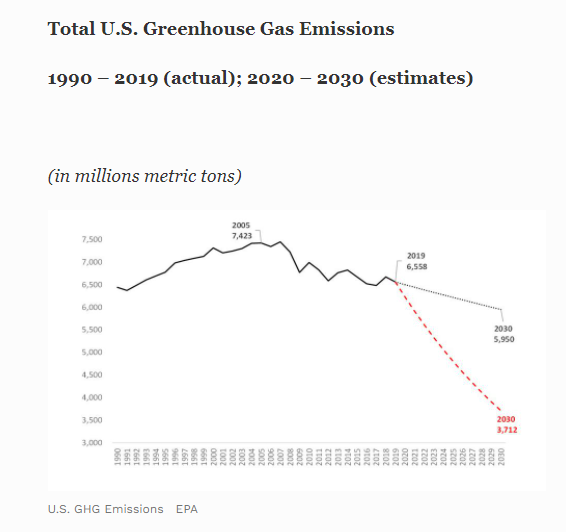At the 2021 global climate summit, President Biden committed the U.S. to cut its greenhouse gas emissions in half by 2030. Cutting emissions in half is a great talking point and a satisfying sounding goal. Unfortunately, the 50% - 52% reduction goal is more of a political statement than an achievable policy. Even a cursory look at the data raises serious questions regarding the goal’s achievability.

According to the Environmental Protection Agency (EPA), total greenhouse gas (GHG) emissions in 2019 were around 6.6 billion metric tons of CO2 equivalent emissions (see the black line in the Figure). Relative to the benchmark year of 2005, this means total GHG emissions in the U.S. are down 11.6% (compared to the U.S. emissions peak in 2007, emissions are down 12.0%). On an annual basis, GHG emissions declined approximately 0.9% each and every year between 2005 and 2019.
Under the assumption that the current trends will continue, emissions will decline to a bit under 6.0 billion metric tons by 2030, or a total decline of 19.8 percent compared to 2005 (see the black dotted line in the Figure). Clearly, this progress is important from a global climate change perspective, but insufficient for the Biden Administration. Their goal is for a decline that is more than 2.5 times as large as our current declines (see the red dotted line in the Figure).

Reaching this bigger goal means that the decline in emissions over the next 9 years needs to accelerate from 0.9% annually to a much higher average annual decline of 5.0%, or more than five times the actual rate of decline since 2005.
So, is such an acceleration in the decline of GHG gasses feasible?
According to the EPA, the transportation sector is the biggest emitter of GHG emissions. If the decline in emissions continued at its current rate through 2030, and all emissions from the transportation sector were eliminated in addition to these declines, a nonsensical scenario, the U.S. emissions would only be 45% lower in 2030 compared to 2005. In other words, even adding a complete elimination of the emissions from the transportation sector to our current progress at reducing emissions is insufficient to meet the 50% reduction goal.
This scenario is even more nonsensical than it sounds because electric vehicles (EVs) need to be connected to the electric grid. Since the power grid generates GHG emissions, eliminating the direct emissions of the transportation sector will result in increased emissions from electricity generation. Depending on the power source, these increased emissions could significantly offset much of the emissions decline from the transportation sector. Therefore, putting more EVs on the road can only reduce transportation emissions by increasing emissions from electricity generation.
Further, producing EVs is a very GHG intensive process that emits more GHGs than the production of a vehicle with an internal combustion engine. If the production of the batteries occurs elsewhere, then these emissions may not count against the 50% reduction goal. Nevertheless, from a global perspective, emissions were still released.
The production and generation considerations demonstrate that EVs are not zero emission vehicles over their lifetime. Analysts will argue over whether the lifetime emissions of an EV are higher or lower once these emissions are considered. From the perspective of reaching President Biden’s 50% goal, the pertinent issue is that these offsets will occur, further pushing the 50% goal out of reach.
Of course, we have not yet discussed the possibility of reducing the GHG emissions from electricity generation. The best current hope for reliable, low-emission, electricity generation is nuclear power. And, given that internationally it takes 5 to 7 years to build a new plant, it is technologically possible to increase our nuclear power capacity within the desired timeframe and, consequently, significantly reduce our GHG emissions while still producing reliable electricity.
The problem, of course, is that instead of building new nuclear power plants, the U.S. is shutting them down. From Diablo Canyon in California, Indian Point Nuclear Power Plant in New York, and Yankee Nuclear Power station in Vermont, the trend over the past decade has been to reduce the amount of nuclear generation in the U.S., not increase it.
Interestingly, in both Vermont and California where the nuclear power plants have already been decommissioned (the Indian Point Nuclear Power Plant is preparing to shut down now), their decline in emissions has been less than the national average (-10% and -9%, respectively). When coupled with the growing local resistance to one of the Biden Administration’s favored energy sources (offshore wind), the likelihood that reduced emissions from the generation of electricity can help achieve the goal of a 50% decline in emissions is even more uncertain.
Global climate change is a serious issue, which requires serious policy responses that account for all of the costs and benefits. Setting arbitrary goals that are infeasible is not a serious policy response, and if actively pursued, threatens to do more harm than good.